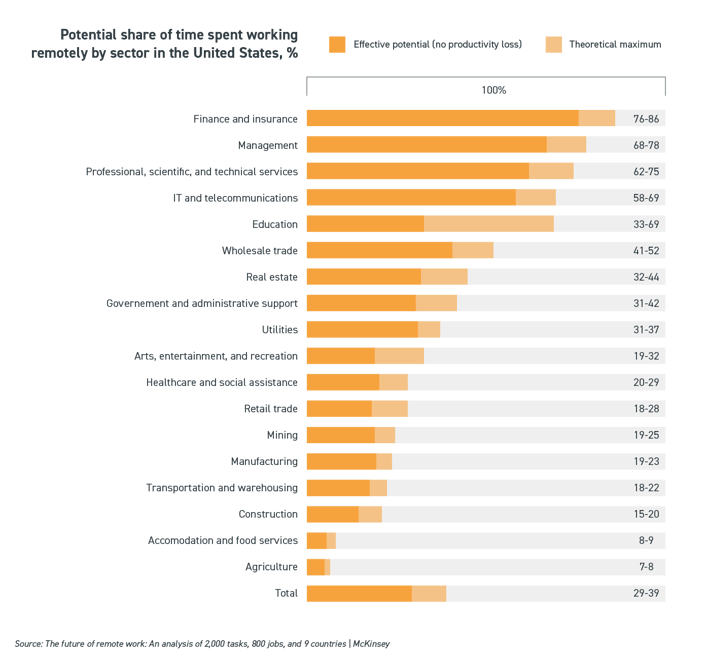By now, the phrases “working from home” or “remote work” are familiar for most businesses. Previously regarded with hesitation and concern, telecommuting has become the norm; heavily influenced and accelerated by the global pandemic. While COVID-19 was the catalyst, other factors over the past few years have played a big part in changing the perspective on the efficiency of remote work practices. Technological advancements by ways of telecommunication platforms, organisational attitude changes towards what constitutes a work-life balance and managers with more traditional working views are retiring are all common themes.
When the global pandemic hit, it became a necessity to allow a work from home set up to ensure business continuity. In fact, back in 2019, only 7% of employees were provided with flexible workplace benefits. That is a staggering difference to the 70% of employees who were working remotely, either full or part-time in April 2020. In 2021, 56% continue to do so.
While the pandemic essentially forced remote work on businesses, it provided leaders with an opportunity to understand the benefits of remote working arrangements and whether it is something to seriously consider post-pandemic. Major corporations like Ford and Target are seeing favourable results from remote work practices. In fact, they are giving up significant office space to facilitate the realised benefits of working from home. Even Spotify has jumped on the bandwagon, broadcasting to employees that they are able to work anywhere they want, even interstate. Prior to the events of 2020, these working arrangements wouldn’t be as developed and accepted as they are today, but organisations are more or less fortunate to have been given the chance to increase business efficiencies as a result of tough times.
Remote working statistics due to COVID-19
If the tales of Ford, Target and Spotify aren’t enough to push you and your business into re-thinking your own remote work practices, consider the following facts that stemmed from the rise of remote work due to COVID-19:
- 84% enjoy working from home
- 92% would like to do so regularly if given the opportunity
- 45% believe the experience has been better than they expected
- 65% would consider working remotely on a permanent basis.
What made the experience so enjoyable for remote staff? 56% stated lack of commuting as their top benefit, followed by 37% for flexibility and 32% for time saved. With staff satisfaction statistics like these, remote working will likely become an employee expectation and businesses that fail to provide these opportunities, whether that be to existing employees or prospective ones, risk falling behind and quality talent absconding to those that do.
From a business perspective, remote workers were actually more productive than their office-based counterparts. Consider the following key findings from a study performed by Airtasker:
- Office-based employees work 1.4 days less per month than remote employees; which equates to around 17 days less per year
- Remote employees were unproductive for only 27 minutes per day, versus office-based employees who were unproductive for 37 minutes (not including lunch or breaks)
- 22% of in-office employees said their managers were distracting them from work, while only 15% of remote workers raised similar concerns.
Similar findings were revealed by McKinsey, stating that 41% of staff found themselves more productive working from home. Following on from the Airtasker survey, staff retention and job satisfaction rates also increased due to remote work practices, with one in four respondents associating long commutes to the office pre-COVID as a primary reason to quit their job. In fact, remote workers are 13% less likely to leave and stay for around five years compared to in-office employees.
55% of employees who have been given the opportunity to work remotely and are enjoying the benefits state that they would look elsewhere for work if the option to work remotely was taken away from them.
What industries would benefit greatly from remote work practices?
Remote working is an opportunity that not all industries are suited to. For example, tasks requiring the operation of machinery, healthcare workers and even mail couriers don’t really have the capacity or technology to indulge in remote work practices. In the end, in-person interaction is necessary.
To help identify which industries, occupations and activities are best suited for remote work in a post-pandemic world, McKinsey & Co conducted a study of over 2,000 activities, across 800 job roles within nine countries. The results? The top-ranked industries that have the greatest potential for remote work were:
- Finance and insurance
- Management
- Professional, scientific and technical services
- IT and communications.

What these industries have in common are that they all employ knowledge-based workers who do most of their work online. Technology continues to provide these workers with opportunities to perform their duties effectively from anywhere. While those were the main industries found as having the greatest potential, opportunities still exist for those working in marketing, customer service and administration given the ability to be predominantly online.
The benefits of remote working
If you are still not convinced remote working is a viable option, despite the aforementioned stats, the following additional benefits may change your mind.
- Increase in productivity levels: this one is a given. The aforementioned studies show that productivity shouldn’t be a concern with the right remote work processes, practices and procedures in place. Remote workers are often faced with fewer distractions, less office chit-chat and more opportunities to take valuable breaks away from their screen and the rush of an office as required.
- Cost-savings: overheads. In particular, the leasing or buying of office space. This can be a huge expense for businesses and remote work can make use of productive working spaces anywhere in the world, at little to lower cost for businesses. Even the cost of fitting out an office with furniture and supplies or utility bills becomes a thing of the past. Savings related to employee salaries can be found through remote work, with 36% of employees choosing to embrace the benefits of working from home over a pay rise.
- Work-life balance: how can merging your work and home life into one area be good for work-life balance you may wonder? Well, with the increased levels of productivity, work is done more quickly and allows employees to better juggle their tasks alongside any family or social commitments. Less commuting equals more time at breakfast with the family or going on a relaxing walk for coffee before the day begins. These little moments are what result in fewer staff absences too.
- Better communication: technology has ramped up developments and pushed out countless telecommunication tools to support remote work, such as Zoom and Skype. They all have one focus, to ensure seamless communication despite being miles away or even overseas. Meetings have even been considered to be more effective due to calendar bookings becoming more structured to ensure minimal time wastage.
How can your business implement remote work practices?
There are various ways your business can leverage the concept of working from home or remote work. Start by considering the following:
- Invest in the cloud: cloud computing means less money is spent on infrastructure and unnecessary equipment. It also reduces the burden on your IT support staff and allows for easy collaboration and file sharing.
- Integrate automation software: to avoid your remote workers feeling disconnected, automation software can reduce the need for them to complete time-consuming and repetitive tasks such as invoicing.
- Implement research collaboration and communication tools: the likes of monday.com, Slack, Google Drive and Trello were made for businesses who want to follow up on work progress seamlessly and share information across the business in a central file location. The likes of Zoom, Skype, Microsoft Teams and Google Meet were introduced to communicate with remote employees and offer a conversation platform despite location differences.
What resourcing strategies can support a remote working model?
To make the most out of remote work, consider various resourcing strategies that can help your business grow and thrive. These strategies include:
- Global talent pool access: instead of sticking to traditional working models like the 9-5 work day, why not consider accessing talent from around the world. Technology makes this all the more possible, tapping into an abundance of highly qualified and skilled workers.
- 24/7 support: providing exceptional customer service is key in today’s modern world and involves around-the-clock care as an expectation. Remote working can help. Outsourcing, in particular, can assist with global time differences and lower salary costs allowing organisations to engage in expert advice on setting up a 24/7 support team that may otherwise be too hard to set up themselves.
- Cybersecurity awareness: no matter how many employees begin to work remotely, making sure your information is secure, whether it be online or over the cloud, is crucial to remote work success. Implementing authentication or authorization procedures within staff’s own devices can help eliminate security gaps and monitor cyber strategies. Outsourced IT services are also extremely effective with cybersecurity maintenance.
Remote work has highlighted the benefits of outsourcing for organisations to employ qualified staff and teams overseas, making use of the global talent pool available thanks to technology. Roles that can be easily outsourced to countries such as the Philippines include:
- Administration assistants
- Accountant
- Bookkeeper
- Copywriter
- Customer service representative
- Desktop support specialist
- Digital marketing specialist
- Insurance claims processor
- IT helpdesk specialist
- Payroll processor
- Property management assistants
- Sales support; inbound
- SEO and SEM specialist
- Systems administrators
- Talent acquisition specialists
- Virtual assistants
- Web developers.
It’s evident that COVID-19 has changed the way we do business, and remote working offers an opportunity to get the most out of one’s resources. With evident productivity gains and cost savings across the board, businesses should seriously consider whether remote work practices are viable for them to implement post-pandemic.
Remote work and outsourcing
Remote work and outsourcing share many similarities. For example, remote work for your organisation means having your internal employees work outside of the business. Outsourcing means hiring external employees to work outside of your business. Either way, a task or set of tasks are being completed outside the ‘four walls’ of your main workplace. Want to leverage the power of an offshore team? Discover the 10 offshore roles you need now to boost your capability and grow your margins.














































.jpg?width=299&height=196&name=Mega%20Menu_FAQs%20(1).jpg)








